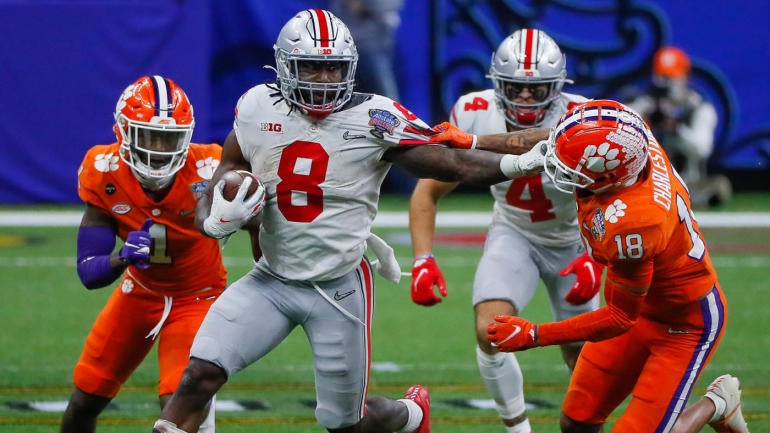
No. 3 Ohio State already shocked the college football world once by boat-racing No. 2 Clemson in the Sugar Bowl 49-28. Now, in the College Football Playoff National Championship against top-ranked Alabama, the Buckeyes can do it again. How they'll pull off two upsets -- they're 8-point underdogs, similar to the Clemson game -- lies in their ability to keep up with Alabama's prolific offense.
And it is prolific, featuring Heisman Trophy-winning wide receiver DeVonta Smith, Heisman finalist quarterback Mac Jones, All-America running back Najee Harris, one of the best offensive lines in the nation and speed at every skill position. This is an offense averaging 48 points per game, which, even though it ranks second nationally, is the country's best over 12 games. The Crimson Tide have scored more touchdowns (77) than any other team and are tied for first with BYU for the most yards per play (7.84). Only twice this year has Alabama scored fewer than 40 points and the lowest total in two years (31) came a week ago against Notre Dame.
It's possible Ohio State's defense rises to the occasion and slows down college football's most terrifying show of offensive talent. The Fighting Irish tried to, but they were overmatched and the Rose Bowl was never in doubt. More likely, the Buckeyes will have to at least match the Crimson Tide's offense, going up and down the field in a game that could hit the over on the point total (75). The good news for Ohio State is that it has the speed and talent to do it. With a win, the Buckeyes would be the biggest underdog to win a national title in nearly 20 years -- which, coincidentally, was also Ohio State.
The underdog is 5-1 in the previous six CFP champ games. Alabama (-7.5) is the biggest favorite in the CFP era and largest of any title game since FSU was -9 vs Auburn in 2013 BCS champ game. An Ohio St win would be biggest upset in a champ game since tOSU beat Miami in '02.
— Dennis Dodd (@dennisdoddcbs) January 6, 2021
Here's how Ohio State can keep up with Alabama to win its second national title in the playoff era.
Justin Fields' mobility must be a factor
Fields' health is of top concern here and it might be the X-factor for the game itself. Coach Ryan Day said this week he "definitely expects" Fields to play after the junior took a brutal shot to the midsection against Clemson. Though in obvious pain, Fields played out of his mind for the rest of the evening and ended with 385 yards passing and six touchdowns. It's not clear exactly what his injury is, but he's going to play through it as best he can.
Fields is an elite passer with a cannon for an arm. His 56-yard touchdown bomb to Chris Olave in the third quarter against Clemson was a drop in the bucket, in stride, with pressure in his face. That was poise, arm strength and ball placement; it was Fields at his absolute best.
There's no doubt Fields can stretch the field vertically, but what will make him particularly dangerous against Alabama is his ability to contribute with his legs. Yes, he is a fast runner when he decides to tuck it and take off. A bit of a long strider, he covers more ground than it might appear and he's excellent at finding even the slightest creases for extra yardage. He'll be the most athletic runner Alabama has faced this season.
But his athleticism is also critical in the passing game. This goes beyond rolling out of the pocket to buy extra time. Defenses have to respect designed play-action passes that take advantage of Fields' threat as a runner. Here, against Penn State, Fields fakes a QB power and finds tight end Jeremy Ruckert:
Justin Fields on 4th and 1 to Jeremy Ruckert. Fields: 27-33 for 306 yards and 4 touchdowns. pic.twitter.com/oYj3yJ1gln
— The Buckeye Nut (@TheBuckeyeNut) November 1, 2020
Day also does a good job of creating these types of opportunities for Fields by rolling him out in either play-action or RPO. Again, Ohio State has to be careful in how it balances Fields' usage as a runner if he's less than 100%. How many designed chances he gets to take off and run remains to be seen, but since he can create his own plays with his legs, that has to be factored into Alabama's defensive game plan, too.
Take advantage of wide receiver speed
College football is already a quarterback's game, but it's also been trending towards being a wide receiver's game for some time. The value placed on speedy wideouts who can create separation has never been higher and it's no surprise that the two teams playing in the national title have invested the most in obtaining a wealth of blue-chip talent at the position. Alabama may be the poster child for this with Smith, Jaylen Waddle, John Metchie III et al, but Ohio State shouldn't be overlooked, either. Chris Olave and Garrett Wilson are one of the best receiver duos in the country. Together, they have accounted for about 70% of Ohio State's receiving yards and 57% of its touchdown catches. Freshman Jaxon Smith-Njigba looks like a future star, too, once it's his turn.
One of the best matchups is going to be Alabama cornerback Patrick Surtain II on Olave and/or Wilson. It'll likely pair future first-round draft picks at one of the most important spots on the field. What makes Olave and Wilson so hard to defend is that they have first-class speed -- Olave's was on display during his 56-yard touchdown shown above -- but they're also excellent route runners. Double moves and pump fakes have been a reliable part of the Ohio State passing arsenal because when Olave or Wilson makes a cut, defenders have to jump on it.
This extends to other routes, too. Take Wilson's touchdown against Nebraska below as an example. Once Fields looks off the safety, he knows he has Wilson one-on-one. Once Wilson made his cut, he was gone for six.
Alabama's defense is good, but you can move the ball on them. The two teams that inflicted the most damage were Ole Miss in October and Florida in the SEC Championship Game. Not coincidentally, Lane Kiffin and Dan Mullen, respectively, are two of the finer offensive minds in the SEC. Ole Miss receivers Kenny Yeboah and Elijah Moore torched the Tide's defense for 324 yards and two touchdowns. Similarly, Florida's Kadarius Toney and Kyle Pitts had a combined 282 yards and two touchdowns in the SEC title game.
If your offense has weapons in the passing game, and Ohio State clearly does, you can beat Alabama through the air. The Buckeyes have speedsters and tacticians catching balls from a guy (Fields) who can deliver it to them down the field.
Lean on Trey Sermon
It would be inaccurate to say that Ohio State didn't have a reliable running game until recently. This is an offense that, at the beginning of the season, averaged a healthy 4.6 yards per carry -- an average that only went up as the year went along. The one criticism of the Buckeyes' ground attack has been that, situationally, Day seemed to get away from it too easily at times. That's been less of a concern over the past two games with Sermon finally taking the reins as RB1. Following up on his 331-yard performance against Northwestern in the Big Ten title game, Sermon rushed for another 193 yards and a score against the Tigers. Though he's a sizable back at 6-foot-1 and 215 pounds, Sermon has light feet and better balance/cutting ability than you'd expect. His explosiveness in the ground attack has been on display over the past two games:
Trey Sermon had 17 runs of 10+ yards in the postseason.
— PFF College (@PFF_College) January 2, 2021
He had 10 in the regular season. pic.twitter.com/FwkUJ158Yw
If Alabama's defense dedicates itself to stopping Olave and Wilson, Sermon is there to clean up. That's what happened against Northwestern with his 331 yards. He's powerful enough to get tough yards after contact, but agile enough to make people miss. He's playing his best football right now and can be a tone setter for the Buckeyes.
Yards/Rush After Contact, P5 in playoff era (min 400 rushes)
— 💫🅰️♈️🆔 (@ADavidHaleJoint) January 6, 2021
1 Travis Etienne, 4.11
2 Jonathan Taylor, 3.55
3 Trey Sermon, 3.44
4. D'Andre Swift, 3.44
5. Ke'Shawn Vaughn, 3.4
Diff between Etienne & No. 2 is same as diff from No. 2 (Taylor) to No. 18 (Bryce Love).
Using tempo wisely
Tempo was a big reason why Ohio State was able to catch Clemson out of sorts in the semifinal. It's not so much that Ohio State went hurry up and no huddle, but rather manipulated the play clock to find the right spots to go with tempo. A good example was Sermon's touchdown run in the first quarter. It's true that Ohio State got the snap off quickly -- but only after allowing more than 20 seconds run off the clock. The result was defensive confusion from the Tigers and a gaping hole for Sermon off the left side.
This is the Sermon TD which came right after Sermon had that attempted hurdle. While the broadcast was showing that hurdle replay a trillion times, Clemson subbed a few guys (no big deal). They had plenty of time to get the call in. And yet ... (right side of the D at snap) pic.twitter.com/4YfflMF20h
— Richard🇬🇾Johnson (@RJ_Writes) January 4, 2021
Tempo is Ohio State's best chance to beat Alabama. The Buckeyes offense has the quarterback, offensive line and skill positions to go with any team in college football. The tools are there. Tempo is how to use them correctly. It's what catches the defense in a bad position and takes advantage of it. It doesn't always mean running plays every 10 seconds, but it can mean moving quickly after substitutions. Combined with pre-snap movement, it can leave the defense bewildered.
The leak TD?
— Richard🇬🇾Johnson (@RJ_Writes) January 4, 2021
Ohio State shifts 1 (one) player.
Clemson shifts the entire middle of their defense. pic.twitter.com/sqArNma3pS
Ohio State used tempo wisely against Clemson. On top of everything else at its disposal to keep up with the Crimson Tide, it'll need to use tempo again to win the national championship.





















